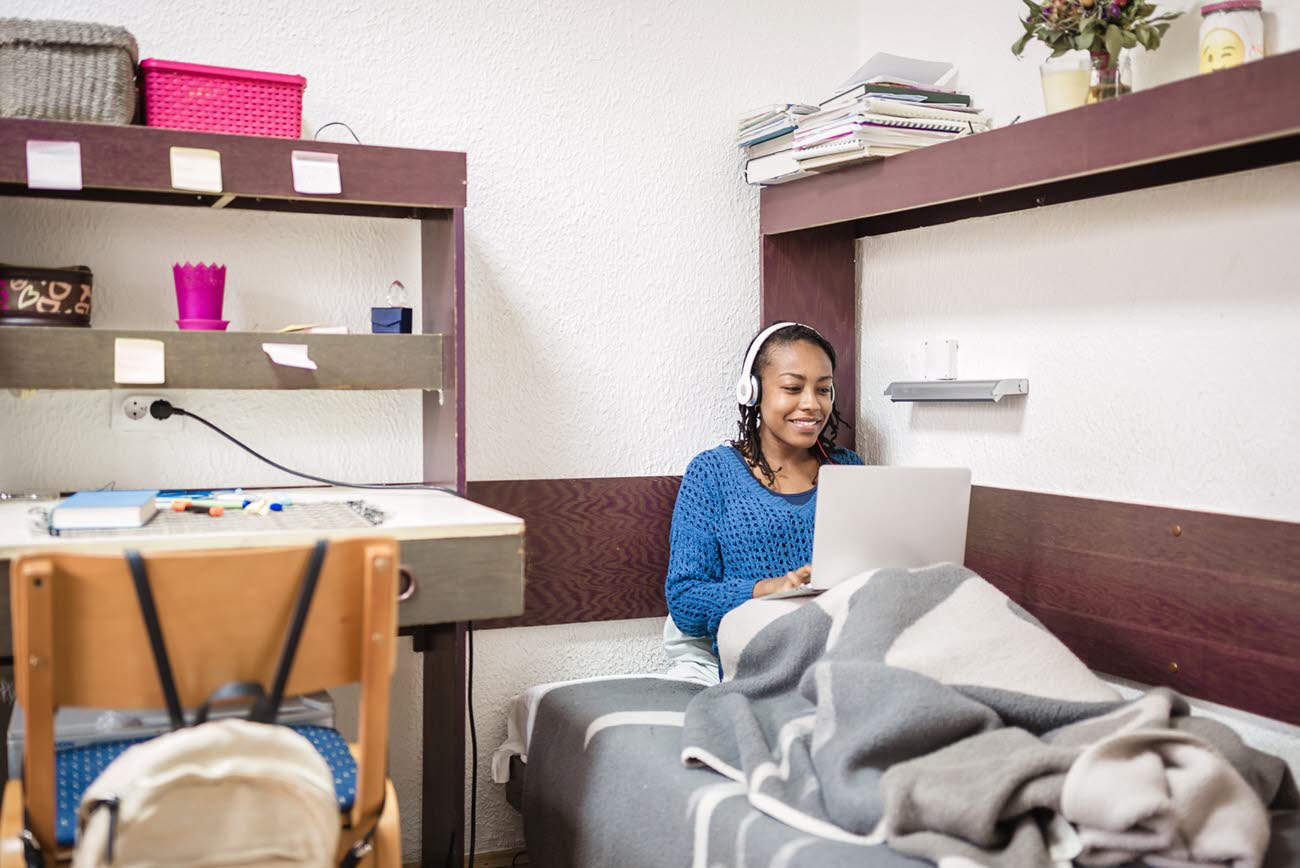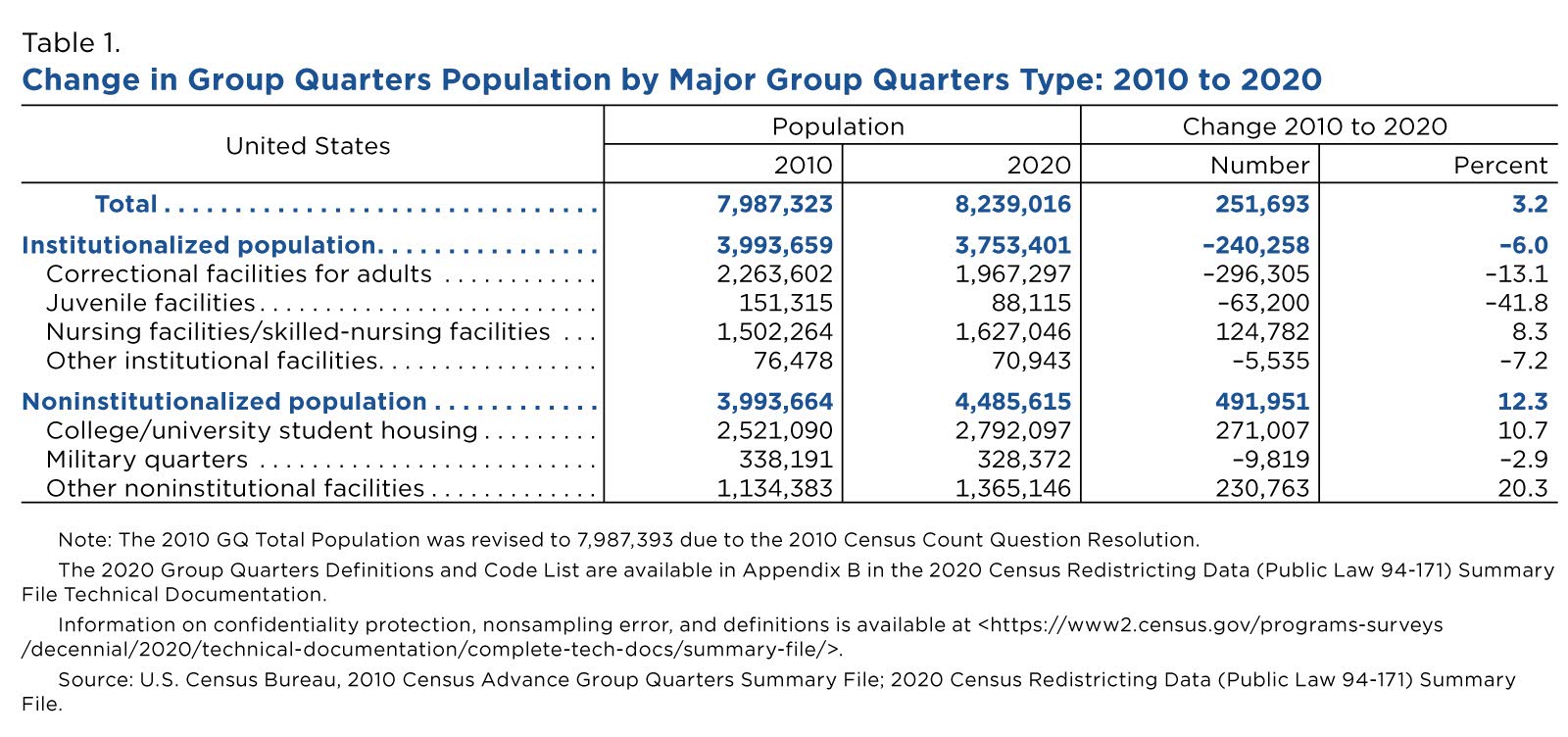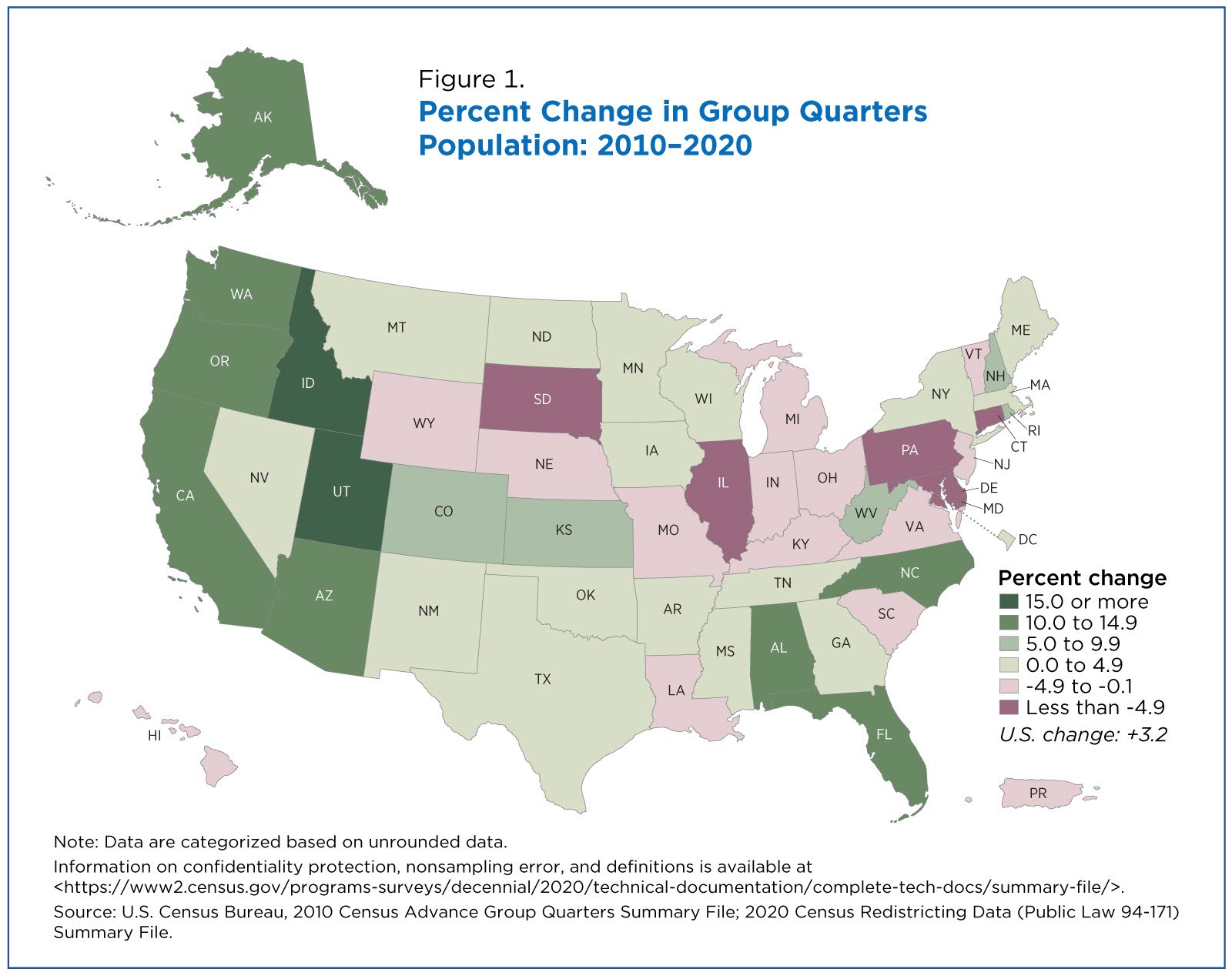New 2020 Census Results Show Group Quarters Population Increased Since 2010
The nation’s group quarters population increased 3.2% from April 1, 2010, to April 1, 2020, to 8,239,016, but it decreased 1.2% in Puerto Rico over the same period to 37,509, according to 2020 Census results released today.
The group quarters population increased in 31 states and the District of Columbia, rising 10% or more in 10 states.
This is the first time since the 2010 Census that group quarters (GQ) populations are available by type of group quarters from the U.S. Census Bureau for geographies below the state level — all the way down to the block level for the United States and Puerto Rico.
What Are Group Quarters?
Group quarters are places where people live or stay in a group living arrangement that are owned or managed by entities or organizations providing housing and/or services for the residents. These services may include custodial or medical care as well as other types of assistance to residents.
Unlike a typical household-type living arrangement, people living in group quarters are usually not related to one another.
Group quarters include such places as college/university student housing, residential treatment centers, nursing/skilled nursing facilities, group homes, military barracks, correctional facilities for adults, and workers group living quarters and job corps centers.
Detailed definitions of GQ types are listed in Appendix B of the 2020 Census Redistricting (P.L. 94-171) Summary File Technical Documentation.
2020 Census National Change
The group quarters population accounted for 2.5% of the total U.S. population in 2020, down from 2.6% in 2010. In some local areas, such as those with a military base or college campus, the group quarters population can be a large share of the overall population.
College/university student housing remained the GQ type with the largest population, growing by 271,007 (10.7%) to 2,792,097 between 2010 and 2020 (Table 1).
The second-largest GQ type population, correctional facilities for adults, decreased by 296,305 (13.1%) to 1,967,297.
Two other GQ types with populations over 1 million saw gains during the decade:
- Nursing facilities/skilled-nursing facilities’ population increased 8.3% to 1,627,046.
- Other noninstitutional facilities’ population increased 20.3% to 1,365,146. Other noninstitutional facilities consists of a diverse set of GQ types, including emergency and transitional shelters for people experiencing homelessness, soup kitchens that offer meals to people experiencing homelessness, targeted nonsheltered outdoor locations, group homes intended for adults, residential treatment centers for adults, and workers group living quarters and job corps centers.
The populations of all other GQ types decreased from 2010 to 2020.
Military quarters, which includes military ships, decreased by 2.9% to 328,372.
The types with the smallest GQ populations — juvenile facilities and other institutional group quarters — also decreased in size by 41.8% to 88,115 and 7.2% to 70,943, respectively.
The decrease in part can be attributed to an update in how juveniles at noncorrectional residential treatment centers were counted. For the 2020 Census, they were counted at their usual home address, if provided, rather than at the facility. For the 2010 Census, they were counted at the facility even if a usual home address was provided.
How Do I Access Data for My Neighborhood (tracts & blocks) from the 2020 Census Redistricting Files?
Get tips and tricks on how to access, visualize and use Census Bureau data. The Census Academy team of data experts these Data Gems.
2020 Census State Level Change
The group quarters population increased in 31 states and the District of Columbia, rising 10% or more in 10 states (Figure 1).
The states with the fastest-growing group quarters populations were Idaho and Utah at over 15%. Nineteen states and Puerto Rico saw a decrease in their group quarters populations, with most declines below 5%.
Six states — Connecticut, Delaware, Illinois, Maryland, Pennsylvania and South Dakota — experienced a drop of 5% or more.
Counting People in Group Quarters
As with each census, these results reflect changes in the population since the last census. These new counts also provide a snapshot of the GQ population during the COVID-19 pandemic, which impacted the GQ population and how specific GQ populations were enumerated.
Amid pandemic-related challenges, we modified our operations and provided additional guidance to ensure people in group quarters were counted and counted in the right place. We summarized these challenges and how we addressed them in a previously published blog about GQs.
We had numerous quality checks built into collecting the data, and we conducted one of the most comprehensive reviews in recent census history during data processing that included additional outreach to some GQs. Anomalies were identified and addressed in the review of the GQ counts.
No census is perfect, and we will continue to evaluate the 2020 Census group quarters enumeration using information from the assessment reports and feedback from the 2020 Census Count Question Resolution program and other outreach programs to apply lessons learned to the 2030 Census.
Reasonableness of the Results
We have taken the time needed to produce the high-quality data that we and the public expect. The GQ population counts by major GQ type at the national, state and lower geographic levels are reasonable compared with 2010 Census and American Community Survey population benchmarks.
Overall, the results by major GQ type are in line with recent trends and consistent with expectations. We are confident that every step has been taken to ensure that the 2020 Census results for group quarters meet our high data quality standards.
Counting the population of every GQ in the nation is an immense task in even normal circumstances. This release includes counts of the GQ population for different GQ types down to the lowest geographic level (the census block) for which the Census Bureau releases data.
Even with the additional efforts made this decade, as with any census, it is expected that some discrepancies for the counts of the population for individual GQs remain. This release is just the beginning of understanding how the nation's GQ population has changed since the 2010 Census, and these GQ counts will be the focus of many other research efforts.
William Koerber is a survey statistician and group quarters subject matter expert at the Census Bureau.
Steven Wilson is chief of the Census Bureau's Population and Housing Programs Branch.
Redistricting & Voting Rights Data Office (RDO)
Visualizations
2020 Census Demographic Data Map Viewer is a web map application that includes state-, county-, and census tract-level data from the 2020 Census.
Data
Fact Sheets
Blog Posts
Newsroom
Census Academy
View training resources for 2020 Census data.
Videos
Maps
-
2020 Census Demographic Data Map ViewerThe 2020 Census Demographic Data Map Viewer is web map application that includes state, county, and tract-level data from the 2020 Census.
-
2020 Census P.L. 94-171 Redistricting Data Map SuiteHere you will find the 2020 Census P.L. 94-171 Redistricting Data Map Suite
-
TIGER/Line ShapefilesView all the available mapping files from the Geography program.
2020 Census Redistricting Data (Public Law 94-171) Summary File News Conference
Subscribe
Our email newsletter is sent out on the day we publish a story. Get an alert directly in your inbox to read, share and blog about our newest stories.
Contact our Public Information Office for media inquiries or interviews.
-
America Counts StoryImproved Race, Ethnicity Measures Show U.S. is More MultiracialAugust 12, 2021Today’s release of 2020 Census data provides a new snapshot of the racial and ethnic composition of the country.
-
America Counts Story2020 U.S. Population More Racially, Ethnically Diverse Than in 2010August 12, 20212020 Census results released today allow us to measure the nation’s racial and ethnic diversity and how it varies at different geographic levels.
-
America Counts StoryMore Than Half of U.S. Counties Were Smaller in 2020 Than in 2010August 12, 2021The U.S. Census Bureau today released the first 2020 Census population counts for counties, metropolitan and micropolitan statistical areas, and cities.
-
America Counts StoryWhat Do We Know About the Quality of 2020 Census Redistricting Data?August 12, 2021To assess the quality of the redistricting data released today, we compared 2020 Census to key data benchmarks.
-
America Counts StoryAdult Population Grew Faster Than Total Population From 2010 to 2020August 12, 2021The first detailed results of the 2020 Census released today show a nationwide shift in the age makeup of the U.S. population from 2010 to 2020.
-
America Counts StoryGrowth in Housing Units Slowed in the Last DecadeAugust 12, 2021The 2020 Census results released today provide a count of vacant and occupied housing units across the nation.
-
America Counts StoryU.S. Housing Vacancy Rate Declined in Past DecadeAugust 12, 2021The percentage of housing units vacant in 2020 dropped to 9.7% from 11.4% in 2010, according to 2020 Census data released this week.
-
America Counts StorySTATE PROFILES: 2020 CensusWe bring you data visualizations with new 2020 Census data for your state and county on: population, race and ethnicity, diversity, age and housing.
-
Business and EconomyEconomic Census Geographic Area Statistics Data Now AvailableApril 07, 2025A new data visualization based on the 2022 Economic Census shows the changing business landscape of 19 economic sectors across the United States.
-
Income and PovertyWhat Sources of Income Do People Rely On?April 02, 2025A new interactive data tool shows income sources for hundreds of demographic and economic characteristic combinations.
-
Business and EconomyBig Improvements to the Annual Integrated Economic Survey (AIES)March 26, 2025The Census Bureau is making several changes and enhancements to capture 2024 economic data based on feedback from last year’s survey.
-
PopulationOnly 50 U.S. Counties Had Populations Over a Million in 2024March 17, 2025A new data visualization highlights U.S. counties between 1970 and 2024 whose populations ever surpassed a million.










